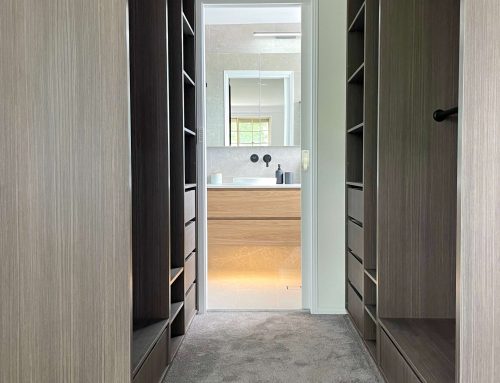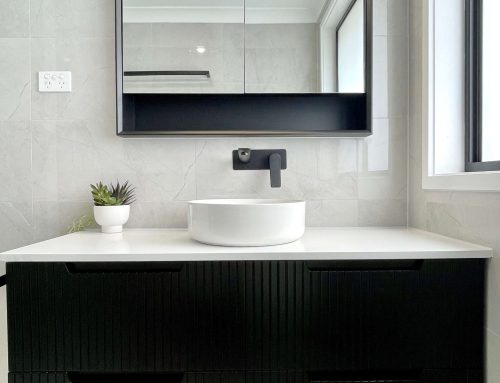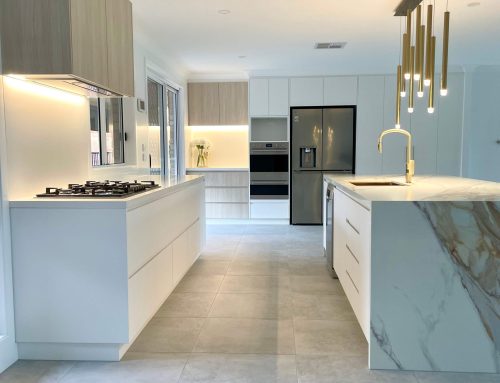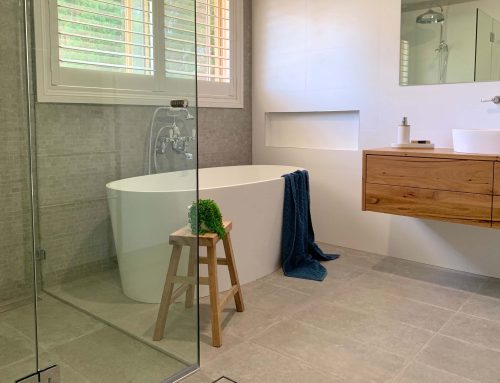Master Bathrooms & Kitchens Renovation Blog
There are a number of things to take into consideration when choosing your tiles for your bathroom renovation.
Tips for choosing tiles for your bathroom renovation.
The overall look and style of your bathroom is largely created by the tiles you choose for your renovation. Selecting tiles for your new bathroom can be quite overwhelming as there are so many different types, styles, sizes and colours from which to choose. There are a number of things to take into consideration when choosing your bathroom tiles to ensure your renovation results as a bathroom masterpiece.

Gorgeous freestanding bath with wall mount antique style cradle bath/shower mixer set perfect for an indulgent soak in the tub set on a stone feature wall – bathroom renovation by Master Bathrooms & Kitchens
Type:
Ceramic tiles are usually made with red, brown or white clay and fired in a kiln and coated with a durable glaze making them non porous. This coated glaze carries the colour and pattern of the tile. Ceramic tiles come in many styles, colours and sizes and are easy to clean and maintain.
Porcelain tiles are tiles are made from a finer, denser clay and fired at much higher temperatures than ceramic tiles. This process results in porcelain tiles having a water absorption rate of less than 0.5% making them the ultimate option for wet areas. Unlike ceramic tiles, porcelain tiles also carry the color/design through the entire thickness of the tile. Porcelain tiles are easy to clean and maintain and are considered the toughest tile option available on the market.
Stone & Timber tiles are perfect to use for a feature within your bathroom, especially if your are going for a natural earthy feel. Natural stone and timber tiles come in a wide range of colours and textures. It is important to remember that natural stone is porous and will require annual sealing to prevent stains and damage. Remember that natural stone is exactly that “natural” so the samples you see in the showroom may differ slightly to what is delivered. Faux stone porcelain tiles are the perfect solution homeowners who love the look of stone without the maintenance.
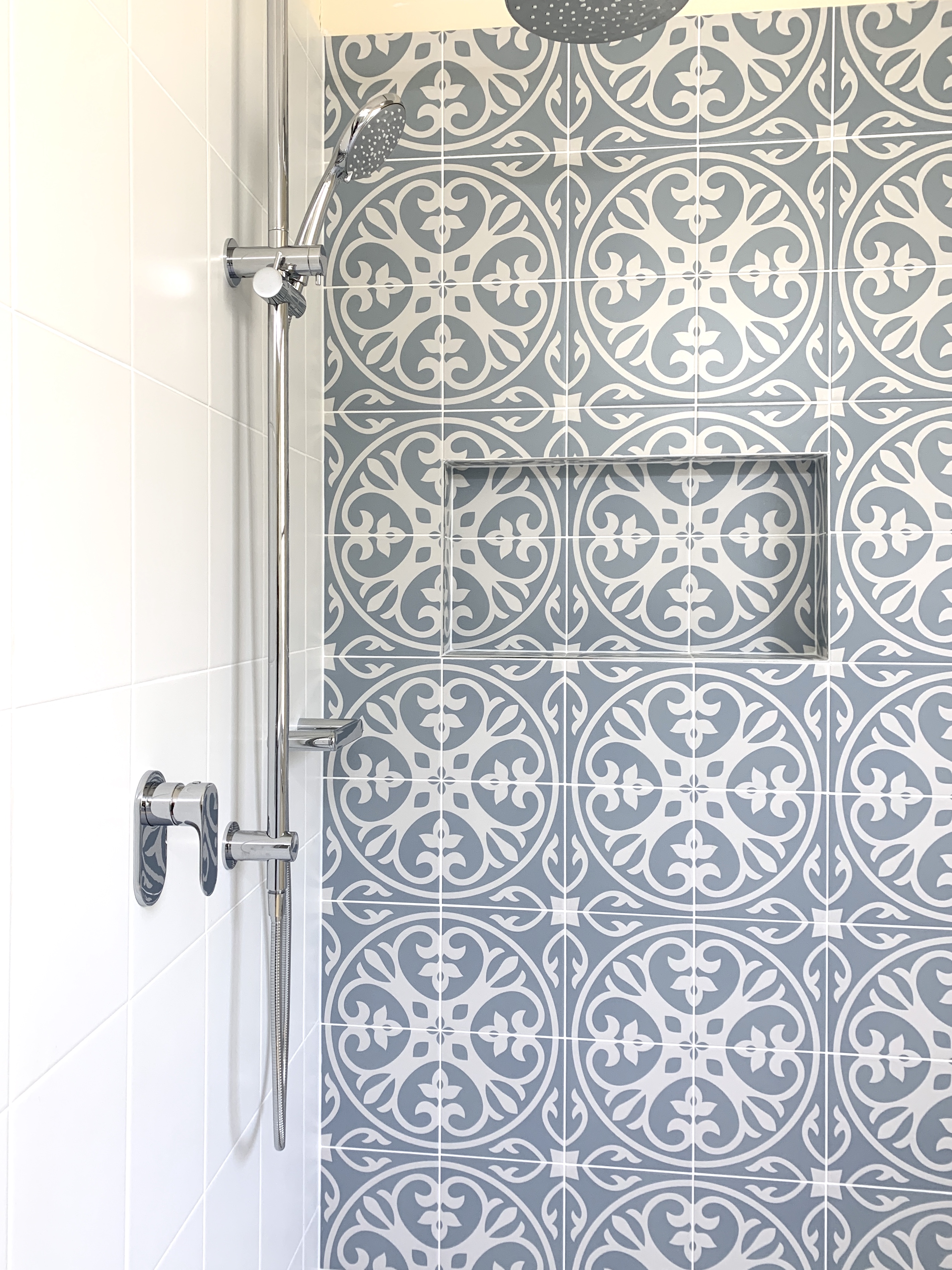
Stunning feature wall with niche adds character to this ensuite bathroom – bathroom renovations by Master Bathrooms & Kitchens.
Texture:
Tiles come in a variety of finishes. Matt, satin, semi-gloss, gloss and high gloss. Which type of texture you choose depends on your individual taste and where the tile is to be used.
Gloss and high gloss tiles are easy to clean and reflect a great amount of light, making a room appear brighter and larger. These are a popular choice for bathroom walls. Gloss tiles reflective nature means that watermarks, fingerprints, dust, dirt etc is easily visible on its surface and will require a little more regular cleaning than satin and matt tiles. It is not advisable to use gloss glazed tiles on floors in wet areas due to the slippery nature of the glaze when wet.
Satin tiles are low sheen tiles that have a slightly glossier glaze than a matt tile and are easy to clean but do not show dirt on the surface as visibly as gloss and high gloss tiles. They reflect light making them perfect in darker type areas and can be used in wet areas.
Matt tiles are the most common form of floor tile in wet areas due to their slip resistance and ability to hide water spots, dust and dirt well. They combine well as a floor tile with gloss wall tiles, although they are often used in larger sized bathrooms on both walls and floors to create a more natural or rustic look. They are incredibly easy to clean without worry of leaving noticeable streak marks.
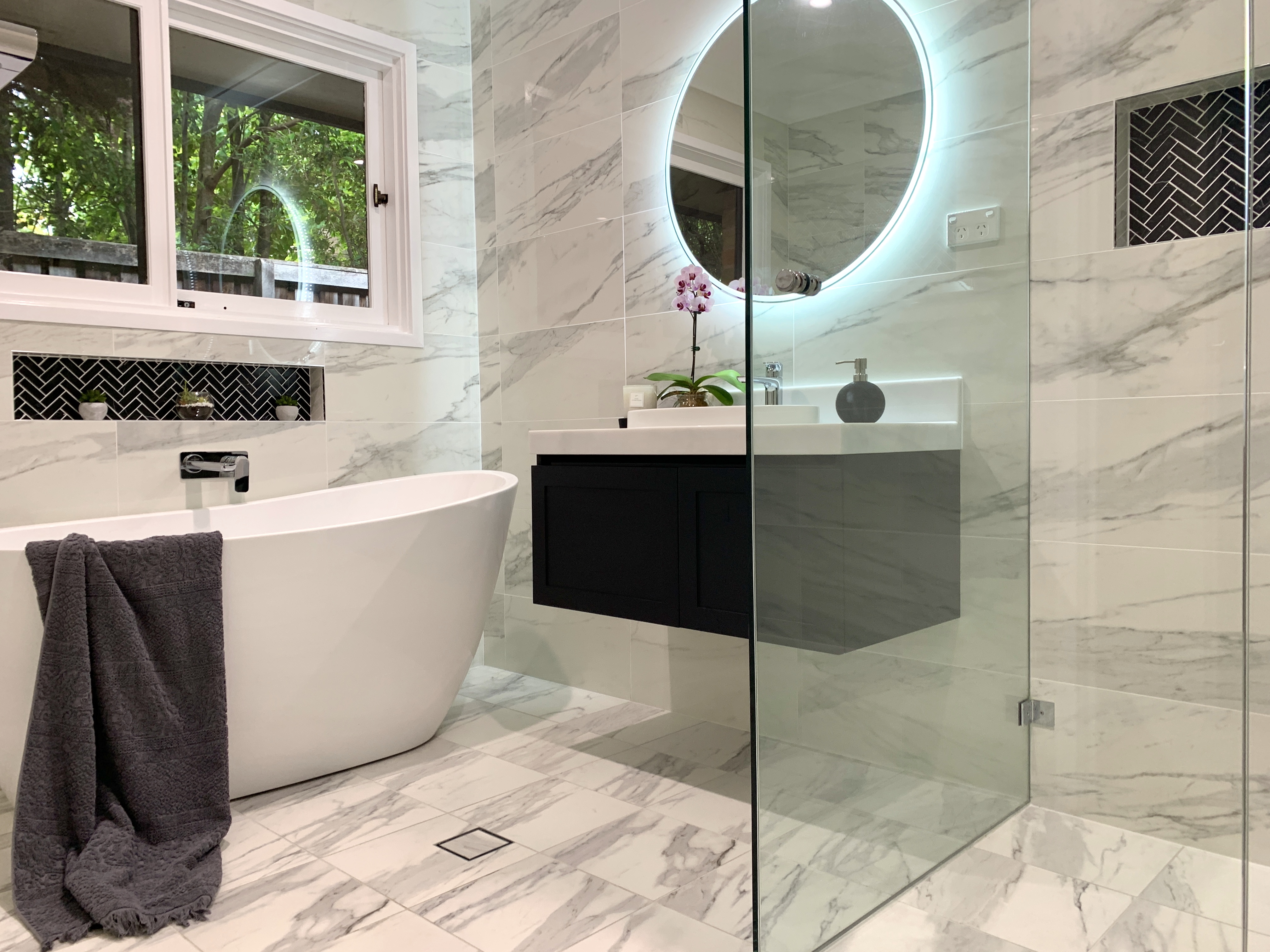
Gorgeous faux marble tiles, backlit mirror, wall mount vanity and freestanding bath – bathroom renovation by Master Bathrooms & Kitchens.
Colour:
As a general rule, limit your tile colours to just three individual colours. Your primary coloured tile will cover the greatest area of your bathroom.
Wall tiles are usually the primary colour tile however, this primary colour tile can also be used on the floor. If your bathroom is a smaller area, it is best if your primary tile colour be a lighter colour. Whites and light coloured neutrals are perfect to use in smaller sized bathrooms as they are timeless, will not date and will give the the bathroom the appearance of being larger.
Floor tiles should compliment your wall tile. It can be the same colour as the primary wall tile with a different texture or it may be a contrast colour tile. If the floor tile is different colour to the wall tile, limit your wall tiles to two colour types, primary and feature. Remember, that the same rule applies here for smaller sized bathrooms, the darker the floor area, the smaller the bathroom will appear.
Feature tiles are used to give your bathroom its “wow factor”. It may very well have been the first tile that caught your eye when you walked into a showroom. Mosaics make beautiful feature tiles as do natural and faux stone tiles, but your feature tile can be any type of tile that appeals to you. The feature tile can be used on an entire wall or part thereof. Most commonly the feature tile is used on the wall where the vanity or bath is to be installed to enhance the item. A feature wall in the shower recess is also a effective feature. Feature tiles look amazing inside niches above baths and in shower recesses. Perhaps a feature floor would better suit your bathroom design. Homeowners of smaller sized bathrooms often prefer to leave their walls white, enhancing the sense of space and choose to create a feature floor either with a patterned, timber or stone tile. The options for feature tiles are quite endless. Be sure to speak with your bathroom renovator about your ideas and options for placement of your feature tile as they will be able to offer you many ideas. Once you have decided on the area for your feature tile, you will then know exactly the quantity to order.
For particularly small bathroom areas, tiling the wall and floor with the same light coloured neutral with a small feature area on a wall is a fantastic way to create a more spacious feel. Small features such a niche tiled in a feature tile above a bath or in the shower is incredibly effective or a simple vertical feature on a single wall. Creating a feature in your bathroom is not limited to tiles alone. This is especially true for smaller sized bathrooms. You may decide to make the vanity your feature by choosing for example one with dark cabinets and matt black tapware.
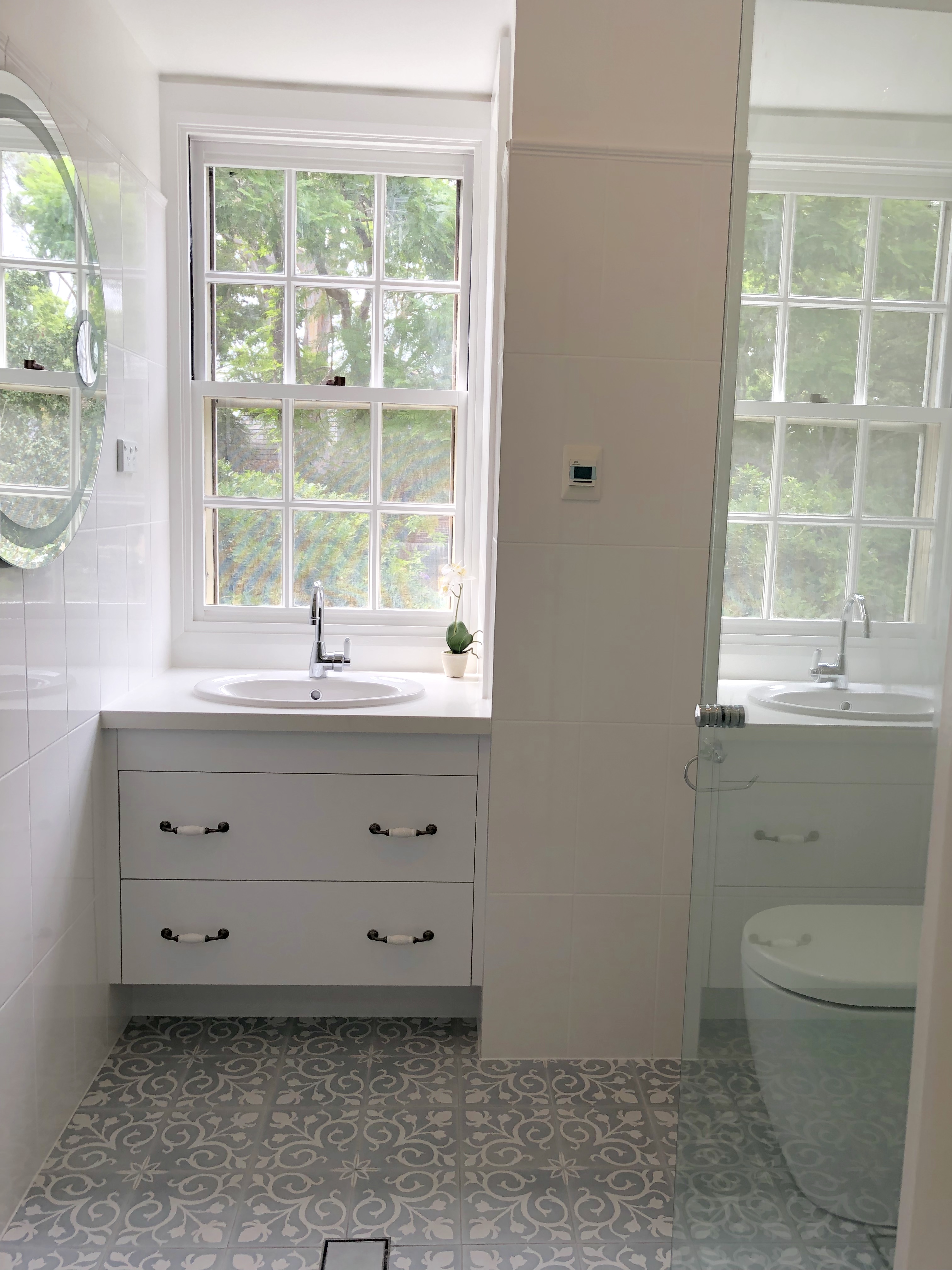
Gorgeous custom made vanity, large round LED switch mirror and feature geometrical floor – bathroom renovation by Master Bathrooms & Kitchens.
For average to larger sized bathrooms, tiling a feature wall with the contrasting floor tile can create a stunning effect and reduces the quantity of or even the need for a separate feature tile altogether.
Mosaic tiles are often displayed in showrooms without grout, be aware that the overall aesthetic of the mosaic tiles will change once grouted. Decide whether you want a white or coloured grout. A contrasting grout will define the shape of the mosaic tile whilst a matching coloured grout will give a more subtle finish.
When shopping for your tiles be mindful that the bright lighting in the showroom will have an effect on the overall look of the tile, so ask if you can take a sample of the tile home with you to get an idea of how it will look in the lighting of your bathroom before placing your order.
Keep in mind that styles and trends go in and out of interior design. When choosing the colour of your tiles be sure to stick with classic colours and patterns that will not date in just a few years. A bathroom renovation is an investment in both time and money. So you want your newly renovated bathroom to look new and relevant for many years to come, not to have to redo it purely to update an outdated colour.
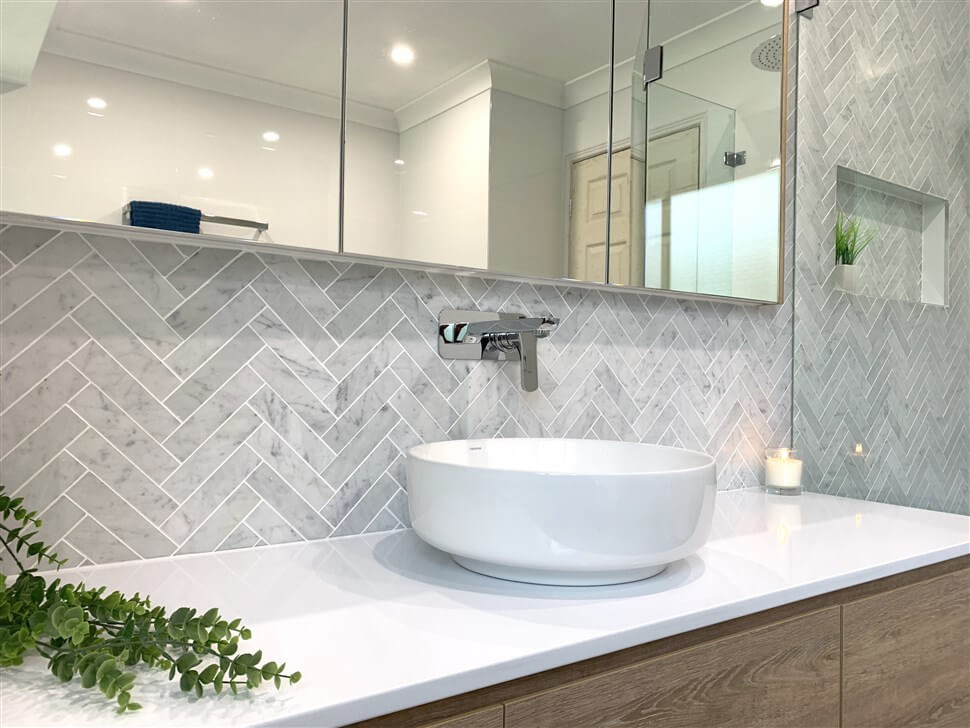
Beautiful custom wall mount vanity with custom recessed mirrored wall cabinet with stunning herringbone tile feature wall – bathroom renovation by Master Bathrooms & Kitchens
Size & Shape:
Tiles come in an array of sizes and shapes. The size, shape and layout of your bathroom will influence the size and shape of your tile. Generally speaking, the larger the room, the larger the tile. That said, larger tiles have the ability to make a small room appear larger as they reduce the amount of grout lines. Although when choosing larger tiles for a smaller bathroom, be sure that the majority of tiles can be applied without cuts. Be sure to speak with your bathroom renovator about what tile size would best suit your bathroom. As a general rule 300 x 300mm is the largest sized floor tile suggested for smaller sized bathrooms.
If you are using different sized tiles within your bathroom, ensure that their proportions work together. It is important that the tiles neatly line up where they meet, again advice from your bathroom renovator regarding size of tiles is imperative.
Related Articles:
Advantages of a Custom Plinth supported vanity – Bathroom Renovations
Ways to Cut the Cost of your Bathroom Renovation
Be Smart with your Bathroom Mirror when Renovating
Master Bathrooms & Kitchens is a bathroom, kitchen & laundry renovation company that has been renovating homes beautiful for over 25 years. We are family owned and operated and offer advice and expertise that only comes from years of experience. Be sure to peruse our website for more renovation inspiration or simply call us on (02) 9899 9330 for a in home measure and quotation today!
Watch our video below for just some of our beautiful bathroom renovations.

